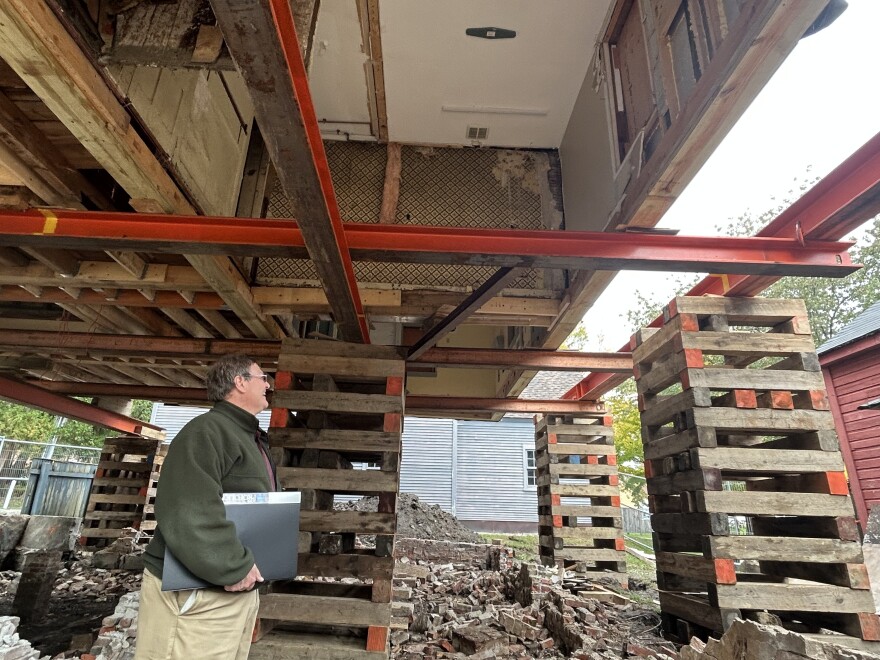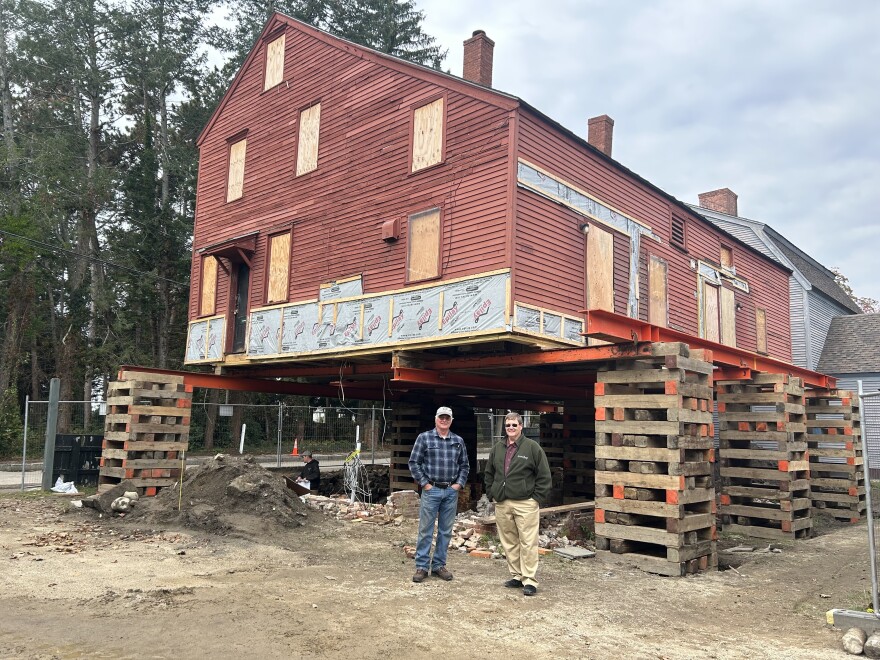The 273-year-old Penhallow House has been through a lot. It moved from one plot of land to another around 1860 and survived a fire in the 1990s. Much of its longevity is thanks to the care of the Strawbery Banke Museum, which is preserving the structure alongside 28 other historic buildings.
But now, water and increasingly frequent flooding are threatening its foundation.
Strawbery Banke is prone to flooding issues, said Rodney Rowland, the museum's director of facilities and environmental sustainability. The museum is situated around a man-made lawn that used to be a tidal inlet – a body of water connected to the Piscataqua River. As sea levels rise in the Atlantic Ocean with a changing climate, high tides are felt in that river, too.
The Penhallow House, built in 1750 by Samuel Penhallow, a local magistrate and the deacon of a church, is in a particularly vulnerable position. It's at a low point, where water can enter from underground, as well as stream in from the streets of Portsmouth during a rainstorm.
So on a sunny Wednesday in October, Rowland watched the house be raised ten feet into the air on steel beams, balanced on top of stacked wood.

“It was very nerve wracking,” he said, looking up at the house. “I mean, these guys know absolutely what they're doing. I've just never seen it up close like this.”
The building won’t stay up high forever. But it had to be raised up high, to allow for a new foundation to be laid – one that can better cope with rising groundwater.
How climate change effects groundwater
As water rises in the Atlantic Ocean, it is pushing up groundwater underneath the Penhallow House’s foundation into the building.
“Effectively what you're doing is you're letting a big tank of water rise, and then everything next to it is going to also be rising,” said Jennifer Jacobs, a professor of engineering at the University of New Hampshire.
Groundwater levels up to two miles inland can rise with sea levels, she said.
Sea levels are projected to rise 10 to 14 inches on the East Coast in the next 30 years, according to the National Oceanic and Atmospheric Administration. Their research shows tides and storm surges will move further inland, and damaging flooding could happen more than 10 times as often.
That’s fueling groundwater rise. But Jacobs said groundwater is going up slow enough that people have time to respond. Communities can build stronger roads, protect themselves from septic systems and landfills that could be affected, and save buildings, although it’s gotten less attention than the coastal problems caused by sea level rise on its own.
“I think people need to be thinking about Strawbery Banke as a really early adopter and an early indicator of potential challenges because they're right there. But that doesn't mean everybody else is scot free,” she said.
Jacobs said groundwater levels can also rise with heavier rainfalls, which New Hampshire is seeing more of as the atmosphere warms. And in addition to water coming up from below, intense storms can flood the Penhallow House, too.
A new foundation
Aaron Sturgis runs Preservation Timber Framing, a company from Maine helping save the house, and this summer, he saw that flooding firsthand. His team was doing work on the bottom of the building, the entire cellar flooded in six minutes.

“I know all of the reasons why we're doing this, preservation minded, climate minded, but then you get a rainstorm, and it just sends it right home,” he said. “We know this is happening now. This is not in the future.”
The primary purpose of the new foundation is to keep as much water out as possible, Sturgis said. But it’s impossible to eliminate all of the water. Groundwater will still rise and could get in. So Sturgis and his team are making the foundation ready for the water to come in, and using a new product that will allow it to drain out while still insulating the space.
“We are using our new concrete foundation to allow this new system of climate mitigation to be installed,” he said. “We're literally filling part of this foundation with new material that allows the water to get out better and faster.”
The decision to fix the foundation was a difficult one for the museum, Rowland said. It came after a lot of disagreement.
“Although as a preservation organization, we typically try to preserve everything, because of the frequency of the water inundation and the projections that it's just going to get worse, there was really no way to do that,” he said. “They didn't build this foundation to be in the water all the time.”
If Samuel Penhallow could see the house now, Rowland said, he’d be a bit mystified. But he said there wasn’t any other choice. To save the house, they had to make a change.








